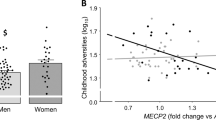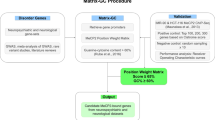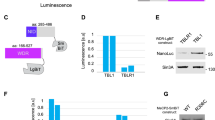Abstract
Investigations of chromosomal rearrangements in patients with mental retardation (MR) are particularly informative in the search for genes involved in MR. Here we report a family with concomitant duplications of methyl CpG binding protein 2 (MECP2) at Xq28 and ATRX (the causative gene for X-linked alpha thalassemia/mental retardation) at Xq21.1 detected by array-comparative genomic hybridization. The alterations were observed in a 25-year-old man who inherited them from his mother, who showed a normal phenotype and completely skewed X-chromosome inactivation, and also in his cousin, a 32-year-old man. The proband and his cousin showed severe MR, muscular hypotonia, recurrent respiratory infections and various other features characteristic of MECP2 duplication syndrome. However, the proband also had cerebellar atrophy never reported before in MECP2 duplication syndrome, suggesting that his phenotypes were modified through the ATRX duplication in an additive or epistatic manner.
Similar content being viewed by others
Log in or create a free account to read this content
Gain free access to this article, as well as selected content from this journal and more on nature.com
or
References
Lugtenberg, D., Kleefstra, T., Oudakker, A. R., Nillesen, W. M., Yntema, H. G., Tzschach, A. et al. Structural variation in Xq28: MECP2 duplications in 1% of patients with unexplained XLMR and in 2% of male patients with severe encephalopathy. Eur. J. Hum. Genet. 17, 444–453 (2009).
Honda, S., Hayashi, S., Imoto, I., Toyama, J., Okazawa, H., Nakagawa, E. et al. Copy-number variations on the X chromosome in Japanese patients with mental retardation detected by array-based comparative genomic hybridization analysis. J. Hum. Genet. 553, 590–599 (2010).
Ramocki, M. B., Tavyev, Y. J. & Peters, S. U. The MECP2 duplication syndrome. Am. J. Med. Genet. A 152A, 1079–1088 (2010).
Hayashi, S., Honda, S., Minaguchi, M., Makita, Y., Okamoto, N., Kosaki, R. et al. Construction of a high-density and high-resolution human chromosome X array for comparative genomic hybridization analysis. J. Hum. Genet. 52, 397–405 (2007).
Kubota, T., Nonoyama, S., Tonoki, H., Masuno, M., Imaizumi, K., Kojima, M. et al. A new assay for the analysis of X-chromosome inactivation based on methylation-specific PCR. Hum. Genet. 104, 49–55 (1999).
Inazawa, J., Azuma, T., Ariyama, T. & Abe, T. A simple G-banding technique adaptable for fluorescent in situ hyblidization (FISH) and physical ordering of human renin (REN) and cathepsin E (CTSE) genes by multi-color FISH. Acta Histochem. Cytochem. 26, 319–324 (1993).
Bartsch, O., Gebauer, K., Lechno, S., van Esch, H., Froyen, G., Bonin, M. et al. Four unrelated patients with Lubs X-linked mental retardation syndrome and different Xq28 duplications. Am. J. Med. Genet. A 152A, 305–312 (2009).
Friez, M. J., Jones, J. R., Clarkson, K., Lubs, H., Abuelo, D., Bier, J. A. et al. Recurrent infections, hypotonia, and mental retardation caused by duplication of MECP2 and adjacent region in Xq28. Pediatrics 118, 1687–1695 (2006).
Lugtenberg, D., de Brouwer, A. P., Oudakker, A. R., Pfundt, R., Hamel, B. C., van Bokhoven, H. et al. Xq13.2q21.1 duplication encompassing the ATRX gene in a man with mental retardation, minor facial and genital anomalies, short stature and broad thorax. Am. J. Med. Genet. A 149A, 760–766 (2009).
Nan, X., Hou, J., Maclean, A., Nasir, J., Lafuente, M. J., Shu, X. et al. Interaction between chromatin proteins MECP2 and ATRX is disrupted by mutations that cause inherited mental retardation. Proc. Natl Acad. Sci. USA 104, 2709–2714 (2007).
Kernohan, K. D., Jiang, Y., Tremblay, D. C., Bonvissuto, A. C., Eubanks, J. H., Mann, M. R. et al. ATRX partners with cohesin and MeCP2 and contributes to developmental silencing of imprinted genes in the brain. Dev. Cell 18, 191–202 (2010).
Gibbons, R. J., McDowell, T. L., Raman, S., O′Rourke, D. M., Garrick, D., Ayyub, H. et al. Mutations in ATRX, encoding a SWI/SNF-like protein, cause diverse changes in the pattern of DNA methylation. Nat. Genet. 24, 368–371 (2000).
Law, M. J., Lower, K. M., Voon, H. P., Hughes, J. R., Garrick, D., Viprakasit, V. et al. ATR-X syndrome protein targets tandem repeats and influences allele-specific expression in a size-dependent manner. Cell 143, 367–378 (2010).
Lee, J. A., Carvalho, C. M. & Lupski, J. R. A DNA replication mechanism for generating nonrecurrent rearrangements associated with genomic disorders. Cell 131, 1235–1247 (2007).
Carvalho, C. M., Zhang, F., Liu, P., Patel, A., Sahoo, T., Bacino, C. A. et al. Complex rearrangements in patients with duplications of MECP2 can occur by fork stalling and template switching. Hum. Mol. Genet. 18, 2188–2203 (2009).
Acknowledgements
This work is part of an ongoing study by the Japanese Mental Retardation Research Consortium. We thank the patients and their families for their generous participation in this study, N Murakami for cell culture and EBV-transformation, and M Kato, A Takahashi and R Mori for their technical assistance. This work is supported by grants-in-aid for Scientific Research on Priority Areas and the Global Center of Excellence Program for Frontier Research on Molecular Destruction and Reconstitution of Tooth and Bone from the Ministry of Education, Culture, Sports, Science, and Technology, Japan; by a grant from the New Energy and Industrial Technology Development Organization (NEDO); and in part by a research grant for Nervous and Mental Disorders from the Ministry of Health, Labour and Welfare, Japan. This work is also supported by Joint Usage/Research Program of Medical Research Institute, Tokyo Medical and Dental University. S.Honda is supported by a Research Fellowship of the Japan Society for the Promotion of Science (JSPS) for Young Scientists.
Author information
Authors and Affiliations
Consortia
Corresponding author
Additional information
Supplementary Information accompanies the paper on Journal of Human Genetics website
Supplementary information
Appendix
Appendix
Yu-ichi Goto, Department of Mental Retardation and Birth Defect Research, National Institute of Neuroscience, National Center of Neurology and Psychiatry, Tokyo, Japan; Johji Inazawa, Department of Molecular Cytogenetics, Medical Research Institute and School of Biomedical Science, Tokyo Medical and Dental University, Tokyo, Japan; Mitsuhiro Kato, Department of Pediatrics, Yamagata University School of Medicine, Yamagata, Japan; Takeo Kubota, Department of Epigenetic Medicine, Interdisciplinary Graduate School of Medicine and Engineering, University of Yamanashi, Yamanashi, Japan; Kenji Kurosawa, Division of Medical Genetics, Kanagawa Children’s Medical Center, Yokohama, Japan; Naomichi Matsumoto, Department of Human Genetics, Yokohama City University Graduate School of Medicine, Yokohama, Japan; Eiji Nakagawa, Department of Mental Retardation and Birth Defect Research, National Institute of Neuro- science, National Center of Neurology and Psychiatry, Tokyo, Japan; Eiji Nanba, Division of Functional Genomics, Research Center for Bioscience and Technology, Tottori University, Yonago, Japan; Hitoshi Okazawa, Department of Neuropathology, Medical Research Institute, Tokyo Medical and Dental University, Tokyo, Japan; Shinji Saitoh, Department of Pediatrics, Hokkaido University Graduate School of Medicine, Sapporo, Japan; and Takahito Wada, Department of Medical Genetics, Shinshu University School of Medicine, Matsumoto, Japan.
Rights and permissions
About this article
Cite this article
Honda, S., Satomura, S., Hayashi, S. et al. Concomitant microduplications of MECP2 and ATRX in male patients with severe mental retardation. J Hum Genet 57, 73–77 (2012). https://doi.org/10.1038/jhg.2011.131
Received:
Revised:
Accepted:
Published:
Issue date:
DOI: https://doi.org/10.1038/jhg.2011.131
Keywords
This article is cited by
-
IRAK1 Duplication in MECP2 Duplication Syndrome Does Not Increase Canonical NF-κB–Induced Inflammation
Journal of Clinical Immunology (2023)
-
A brief history of MECP2 duplication syndrome: 20-years of clinical understanding
Orphanet Journal of Rare Diseases (2022)
-
Clinical and molecular genetic characterization of familial MECP2 duplication syndrome in a Chinese family
BMC Medical Genetics (2017)
-
Infectious and Immunologic Phenotype of MECP2 Duplication Syndrome
Journal of Clinical Immunology (2015)
-
Microarray-based ultra-high resolution discovery of genomic deletion mutations
BMC Genomics (2014)



